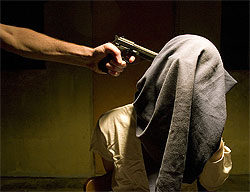Causalities of War
Journalists used to be seen as neutral, but now they're ransom bait, bargaining chips or the outright enemy. Last year was the worst on record for correspondents getting killed on the job—and in 2006, the trend continues
On February 23, the bodies of correspondent Atwar Bahjat, cameraman Khaled Mahmoud al-Falahi and engineer Adnan Khairallah were found near Samarra, Iraq. Bahjat was a correspondent for Al-Arabiya, while al-Falahi and Khairallah were employees of Wasan Productions on assignment for Al-Arabiya. The Wasan crew was covering the bombing of a Shiite shrine near Samarra, Iraq, when armed men attacked them and demanded to know the whereabouts of Bahjat. Their last broadcast was at 6 P.M. the day before their bodies were found.
On February 2, Wu Xianghu, deputy editor of Taizhou Wanbao, died of liver and kidney failure after months of hospitalization. He was attacked by traffic police in the eastern coastal city of Taizhou, Zhejiang province, China, in October 2005, after writing an embarrassing exposé of high fee collections for electric bicycle licenses.
On January 25, Baghdad TV correspondent Mahmoud Za’al was shot and killed in a U.S. air strike while covering an insurgent attack by Sunni rebels on two U.S.-held buildings in Ramadi, Iraq. He had worked for the station for one year.
On January 24, the day before, Subramaniyam Sugitharajah, a part-time reporter for the Sudar Oli, was killed by an unidentified gunman on his way to work. Photographs taken by Sugitharajah had shown that five students in Tamil, Sri Lanka, had been killed by gunshot wounds January 2, despite claims by the military that the men were blown up by their own grenade in an attempted attack on the army.
And on January 6, Prahlad Goala of the Asomiya Khabar was murdered near his home in Golaghat, Assam state, India. He had written articles linking local forestry service officials to timber smuggling.
So far this year, seven journalists are confirmed, and two others suspected, dead. At what number this tragic toll stops in 2006 is anyone’s guess and, at least for now, 2005 remains the most violent year in journalism’s history. The International Federation of Journalists (IFJ) reported in January that 150 were killed last year, including forty-eight in a December 6 plane crash in Tehran and eighty-nine “killed in the line of duty, singled out for their professional work.”
The previous record was 129 deaths, set in 2004. The December 26, 2004 tsunami in Southeast Asia claimed eighty-nine journalists, and marked the start of an increasing trend in the field: foreign-location assignments are killing journalists.
“Unfortunately, journalists are now more part of the conflict,” says Douglas Struck, foreign correspondent forThe Washington Post. “It used to be that journalists felt with some degree of accuracy that we were not in the line of fire, that we had a special status as neutral observers that usually kept us pretty safe. That’s clearly not true any more, particularly in Iraq, where journalists are targeted specifically by those on one side.”
The number of recorded deaths depends on differing criteria. The Committee to Protect Journalists (CPJ) estimates forty-seven deaths in 2005, to 2004’s fifty-seven. The CPJ, whose numbers are the most widely cited, also says that a total of eighty-four journalists have been killed in Iraq since the conflict began in 2003. This figure excludes journalists who have died in non-hostile situations, unlike the International News Safety Institute (INSI), which cites 101 as the actual figure of media deaths in the country. The INSI number more closely coincides with the IFJ, reporting 146 casualties for the year 2005 – thirty-three in Asia and eighty-seven in the Middle East.
Though the exact figures differ, the tally might as well be the same: too many. “It’s a big challenge to be a foreign correspondent,” says Paul Loong, world editor for Canadian Press. “You have to be adequately trained and take all the necessary precautions while going about your job.”
But what can be done?
“It depends on the area,” says the Post‘s Struck. “In the past, our major precautions were our own wits. We had to evaluate every place we went – how safe it was, the safest way to approach it, who you can contact safely. For example, a local journalist or translator… are they reliable, do they know the terrain and territory?”
Struck says media personnel are now transported in armoured cars between destinations. Armed guards often accompany them as well, either in the vehicle with them or in a trailing car to protect journalists from being kidnapped for ransom or used as bargaining chips. “We live outside the Green Zone in a compound heavily guarded by men with automatic rifles,” he says. Travel is restricted in Iraq, more so than in Afghanistan and other places. But that’s changing, because now “Afghanistan is looking increasingly dangerous,” he says. INSI reports that three journalists were killed in Afghanistan in 2004, compared to thirty-two in Iraq.
“The problem is the dangers are so often around them and savage in nature,” says David Walmsley, assistant managing editor for national and foreign news at The Toronto Star. “We train our reporters in medical techniques and try to minimize the potential for a random attack.” Walmsley says reporters are also equipped with hard hats, flak jackets, and other safety and medical equipment when on assignment. “What more can you do?”
INSI dedicates an entire section of its site to safety tips for journalists, suggesting they remain neutral and never carry firearms. It is also valuable to understand the history of the area and to take hostile environment courses before going into a conflict zone.
“The people that go to troubled areas of the world tend to be more experienced,” says Loong. “There is never total security, so it’s a matter of being vigilant and knowing the environment that can make the person respond more promptly to threats.”
The most valuable safety precaution is almost universally adopted by news agencies: foreign correspondents volunteer for potentially lethal assignments. “A lot of journalists weigh the dangers of accepting an assignment,” says Struck, “and legitimately decide the danger is not worth the story. Quite frankly, no story is worth being killed for.”
“Anytime we go to conflict zones,” adds Walmsley, “we do it with a great degree of caution.”
Safety organizations respond to the increase in deaths of journalists in any way possible. The CPJ says it protects journalists by publicly revealing abuses against the press, and by acting on behalf of imprisoned and threatened journalists in order to warn others where attacks are occurring. When news correspondents do get into trouble, it can intervene by notifying news organizations, government officials and human rights groups. Journalists in dire situations can also appeal to the CPJ Journalist Assistance Program, which is “intended to aid journalists who have been physically assaulted and need medical attention; those who need to go into hiding or exile to escape threats; and those in prison who have specific, material needs.”
Few Canadian news organizations have their own foreign news departments, and as such aren’t quite as concerned with the alarming trend. Organizations that do, such as CBC, haven’t yet lost staff to hostile environments.
However, the increase in violence toward journalists cannot be ignored. Precautions are being taken, but as the last two years have shown, being careful only goes so far. “The challenges are ones we’ll continually face,” says Walmsley. “They’re not going to go away.”
The seven recent deaths not only prove Walmsley’s point, they also paint a grim forecast. “Hopefully, we don’t pay the same price this year,” he says, “but we may.”
by Rudy Sabga
Rudy Sabga was the Online Editor for the Summer 2006 issue of the Ryerson Review of Journalism.













































